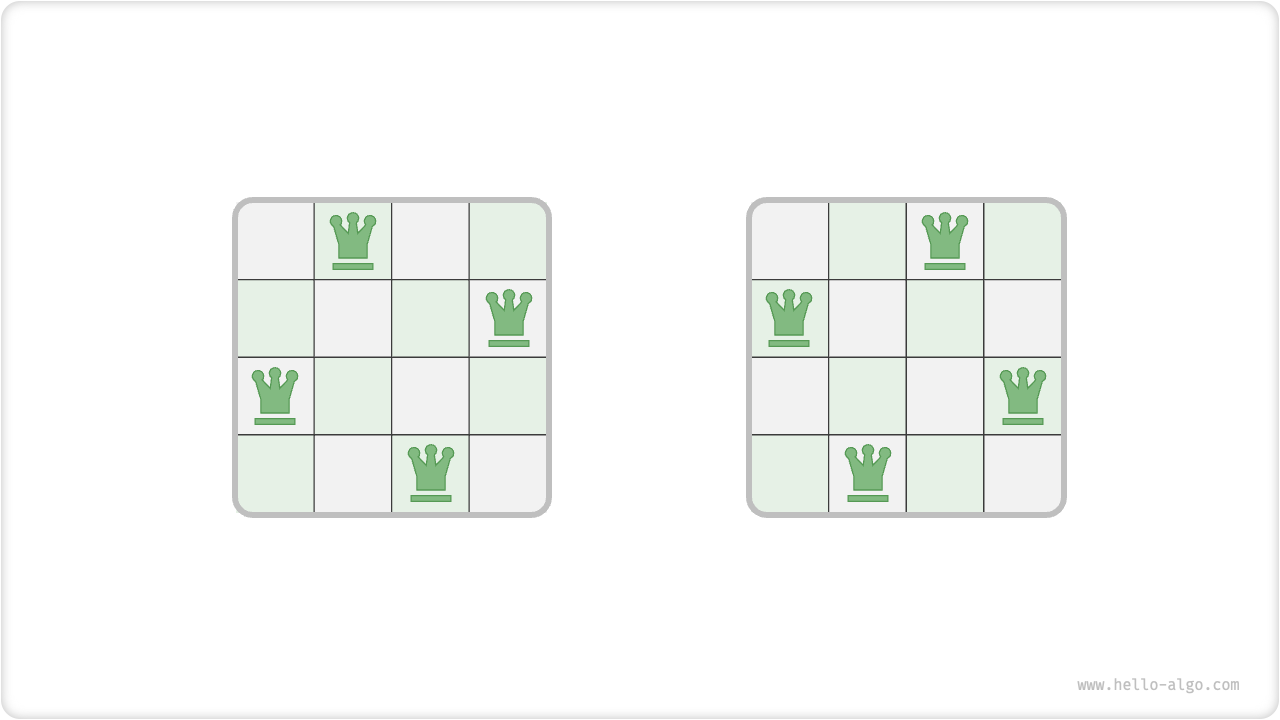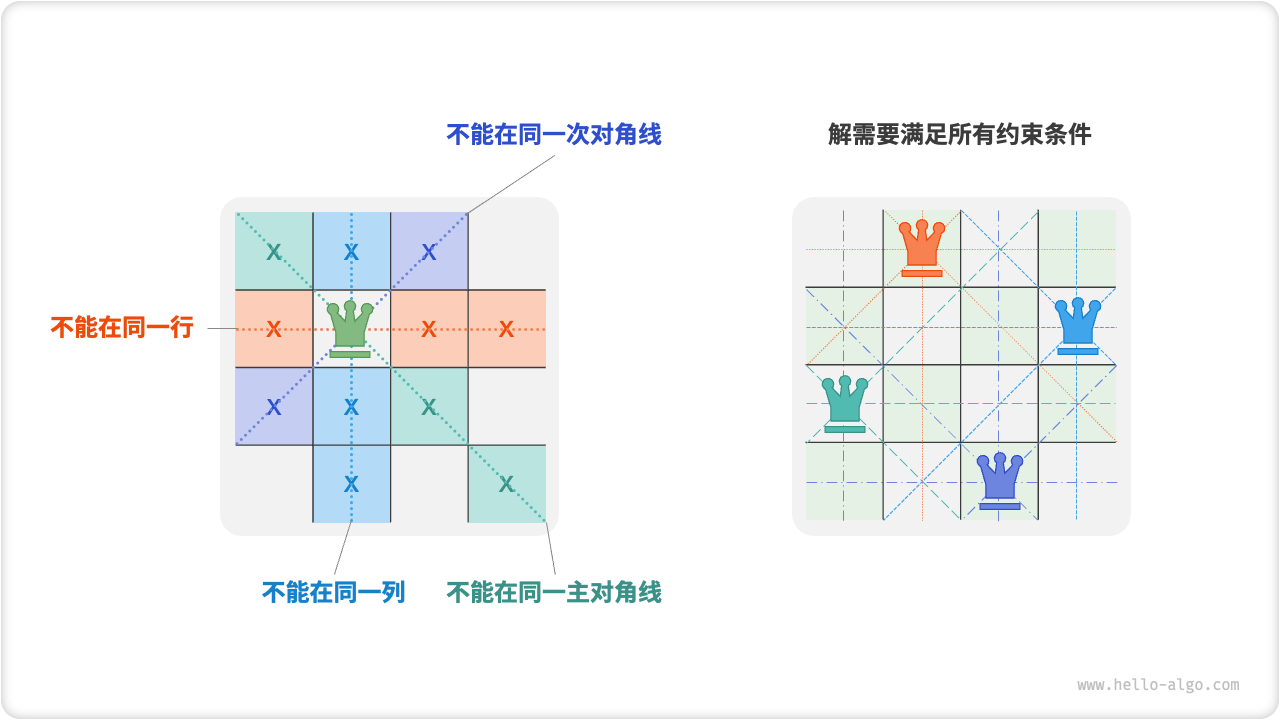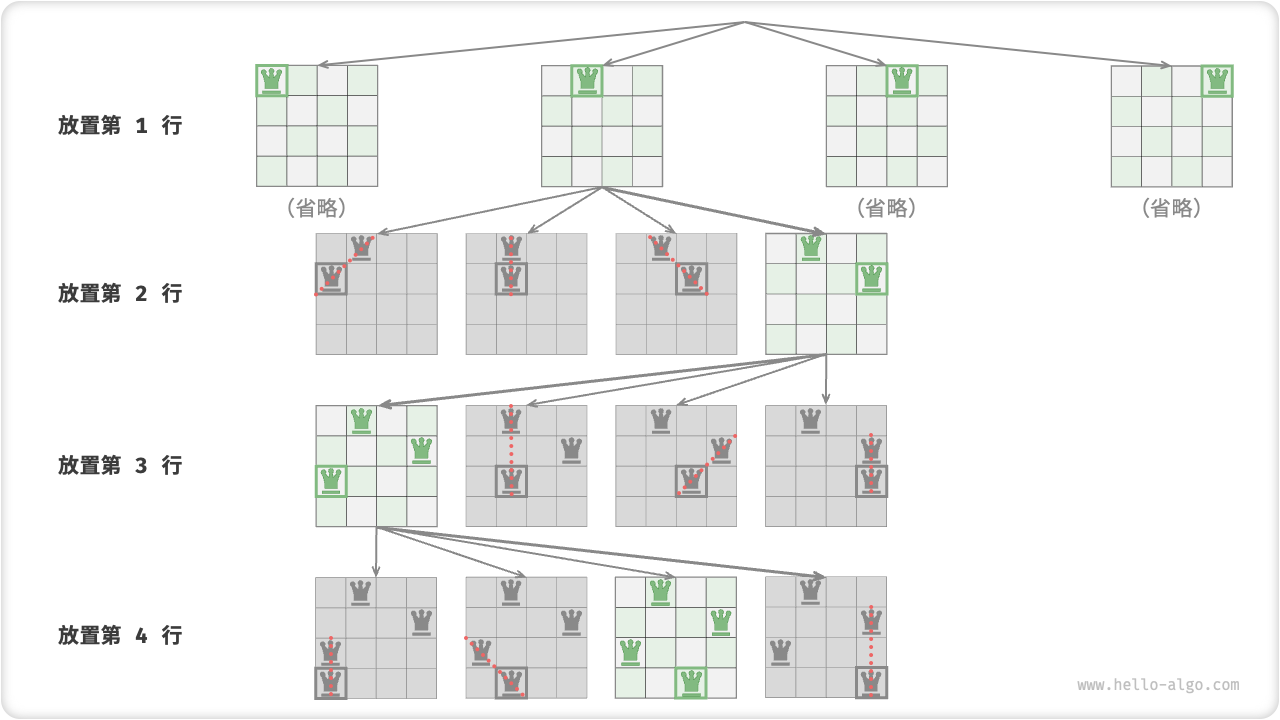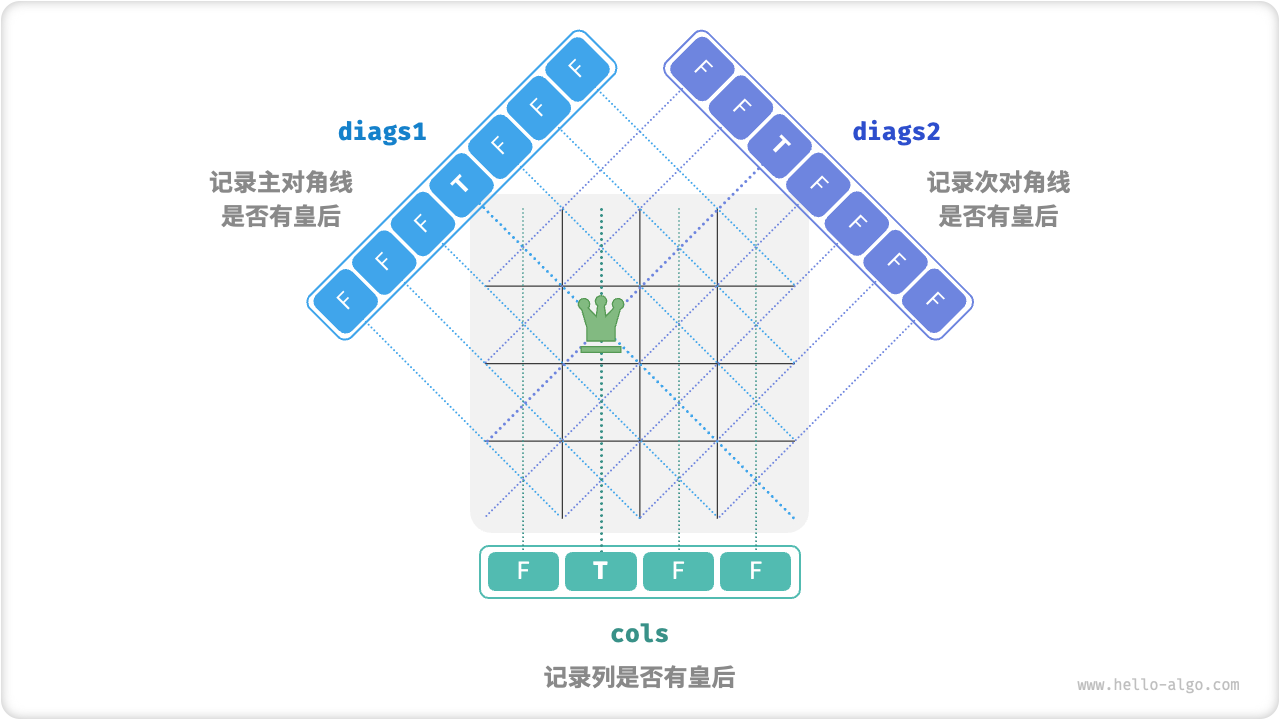13.3. N 皇后问题¶
根据国际象棋的规则,皇后可以攻击与之处在同一行或同一列或同一斜线上的棋子。给定 \(n\) 个皇后和一个 \(n \times n\) 大小的棋盘,寻找使得所有皇后之间无法相互攻击的摆放方案。
如下图所示,当 \(n = 4\) 时,共可以找到两个解。从回溯算法的角度看,\(n \times n\) 大小的棋盘共有 \(n^2\) 个格子,给出了所有的选择 choices 。在逐个放置皇后的过程中,棋盘状态在不断地变化,每个时刻的棋盘就是状态 state 。

Fig. 4 皇后问题的解
本题共有三个约束条件:多个皇后不能在同一行、同一列和同一对角线。值得注意的是,对角线分为主对角线 \ 和副对角线 / 两种。

Fig. n 皇后问题的约束条件
皇后的数量和棋盘的行数都为 \(n\) ,因此我们容易得到第一个推论:棋盘每行都允许且只允许放置一个皇后。这意味着,我们可以采取逐行放置策略:从第一行开始,在每行放置一个皇后,直至最后一行结束。此策略起到了剪枝的作用,它避免了同一行出现多个皇后的所有搜索分支。
下图展示了 \(4\) 皇后问题的逐行放置过程。受篇幅限制,下图仅展开了第一行的一个搜索分支。在搜索过程中,我们将不满足列约束和对角线约束的方案都剪枝了。

Fig. 逐行放置策略
为了实现根据列约束剪枝,我们可以利用一个长度为 \(n\) 的布尔型数组 cols 记录每一列是否有皇后。在每次决定放置前,我们通过 cols 将已有皇后的列剪枝,并在回溯中动态更新 cols 的状态。
那么,如何处理对角线约束呢?设棋盘中某个格子的行列索引为 (row, col) ,观察矩阵的某条主对角线,我们发现该对角线上所有格子的行索引减列索引相等,即 row - col 为恒定值。换句话说,若两个格子满足 row1 - col1 == row2 - col2 ,则这两个格子一定处在一条主对角线上。
利用该性质,我们可以借助一个数组 diag1 来记录每条主对角线上是否有皇后。注意,\(n\) 维方阵 row - col 的范围是 \([-n + 1, n - 1]\) ,因此共有 \(2n - 1\) 条主对角线。

Fig. 处理列约束和对角线约束
同理,次对角线上的所有格子的 row + col 是恒定值。我们可以使用同样的方法,借助数组 diag2 来处理次对角线约束。
根据以上分析,我们便可以写出 \(n\) 皇后的解题代码。
/* 回溯算法:N 皇后 */
void backtrack(int row, int n, List<List<String>> state, List<List<List<String>>> res,
boolean[] cols, boolean[] diags1, boolean[] diags2) {
// 当放置完所有行时,记录解
if (row == n) {
List<List<String>> copyState = new ArrayList<>();
for (List<String> sRow : state) {
copyState.add(new ArrayList<>(sRow));
}
res.add(copyState);
return;
}
// 遍历所有列
for (int col = 0; col < n; col++) {
// 计算该格子对应的主对角线和副对角线
int diag1 = row - col + n - 1;
int diag2 = row + col;
// 剪枝:不允许该格子所在 (列 或 主对角线 或 副对角线) 包含皇后
if (!(cols[col] || diags1[diag1] || diags2[diag2])) {
// 尝试:将皇后放置在该格子
state.get(row).set(col, "Q");
cols[col] = diags1[diag1] = diags2[diag2] = true;
// 放置下一行
backtrack(row + 1, n, state, res, cols, diags1, diags2);
// 回退:将该格子恢复为空位
state.get(row).set(col, "#");
cols[col] = diags1[diag1] = diags2[diag2] = false;
}
}
}
/* 求解 N 皇后 */
List<List<List<String>>> nQueens(int n) {
// 初始化 n*n 大小的棋盘,其中 'Q' 代表皇后,'#' 代表空位
List<List<String>> state = new ArrayList<>();
for (int i = 0; i < n; i++) {
List<String> row = new ArrayList<>();
for (int j = 0; j < n; j++) {
row.add("#");
}
state.add(row);
}
boolean[] cols = new boolean[n]; // 记录列是否有皇后
boolean[] diags1 = new boolean[2 * n - 1]; // 记录主对角线是否有皇后
boolean[] diags2 = new boolean[2 * n - 1]; // 记录副对角线是否有皇后
List<List<List<String>>> res = new ArrayList<>();
backtrack(0, n, state, res, cols, diags1, diags2);
return res;
}
/* 回溯算法:N 皇后 */
void backtrack(int row, int n, vector<vector<string>> &state, vector<vector<vector<string>>> &res, vector<bool> &cols,
vector<bool> &diags1, vector<bool> &diags2) {
// 当放置完所有行时,记录解
if (row == n) {
res.push_back(state);
return;
}
// 遍历所有列
for (int col = 0; col < n; col++) {
// 计算该格子对应的主对角线和副对角线
int diag1 = row - col + n - 1;
int diag2 = row + col;
// 剪枝:不允许该格子所在 (列 或 主对角线 或 副对角线) 包含皇后
if (!(cols[col] || diags1[diag1] || diags2[diag2])) {
// 尝试:将皇后放置在该格子
state[row][col] = "Q";
cols[col] = diags1[diag1] = diags2[diag2] = true;
// 放置下一行
backtrack(row + 1, n, state, res, cols, diags1, diags2);
// 回退:将该格子恢复为空位
state[row][col] = "#";
cols[col] = diags1[diag1] = diags2[diag2] = false;
}
}
}
/* 求解 N 皇后 */
vector<vector<vector<string>>> nQueens(int n) {
// 初始化 n*n 大小的棋盘,其中 'Q' 代表皇后,'#' 代表空位
vector<vector<string>> state(n, vector<string>(n, "#"));
vector<bool> cols(n, false); // 记录列是否有皇后
vector<bool> diags1(2 * n - 1, false); // 记录主对角线是否有皇后
vector<bool> diags2(2 * n - 1, false); // 记录副对角线是否有皇后
vector<vector<vector<string>>> res;
backtrack(0, n, state, res, cols, diags1, diags2);
return res;
}
def backtrack(
row: int,
n: int,
state: list[list[str]],
cols: list[bool],
diags1: list[bool],
diags2: list[bool],
res: list[list[list[str]]],
):
"""回溯算法:N 皇后"""
# 当放置完所有行时,记录解
if row == n:
res.append([list(row) for row in state])
return
# 遍历所有列
for col in range(n):
# 计算该格子对应的主对角线和副对角线
diag1 = row - col + n - 1
diag2 = row + col
# 剪枝:不允许该格子所在 (列 或 主对角线 或 副对角线) 包含皇后
if not (cols[col] or diags1[diag1] or diags2[diag2]):
# 尝试:将皇后放置在该格子
state[row][col] = "Q"
cols[col] = diags1[diag1] = diags2[diag2] = True
# 放置下一行
backtrack(row + 1, n, state, cols, diags1, diags2, res)
# 回退:将该格子恢复为空位
state[row][col] = "#"
cols[col] = diags1[diag1] = diags2[diag2] = False
def n_queens(n: int) -> list[list[list[str]]]:
"""求解 N 皇后"""
# 初始化 n*n 大小的棋盘,其中 'Q' 代表皇后,'#' 代表空位
state = [["#" for _ in range(n)] for _ in range(n)]
cols = [False] * n # 记录列是否有皇后
diags1 = [False] * (2 * n - 1) # 记录主对角线是否有皇后
diags2 = [False] * (2 * n - 1) # 记录副对角线是否有皇后
res = []
backtrack(0, n, state, cols, diags1, diags2, res)
return res
13.3.1. 复杂度分析¶
逐行放置 \(n\) 次,考虑列约束,则从第一行到最后一行分别有 \(n, n-1, \cdots, 2, 1\) 个选择,因此时间复杂度为 \(O(n!)\) 。实际上,根据对角线约束的剪枝也能够大幅地缩小搜索空间,因而搜索效率往往优于以上时间复杂度。
state 使用 \(O(n^2)\) 空间,cols , diags1 , diags2 皆使用 \(O(n)\) 空间。最大递归深度为 \(n\) ,使用 \(O(n)\) 栈帧空间。因此,空间复杂度为 \(O(n^2)\) 。